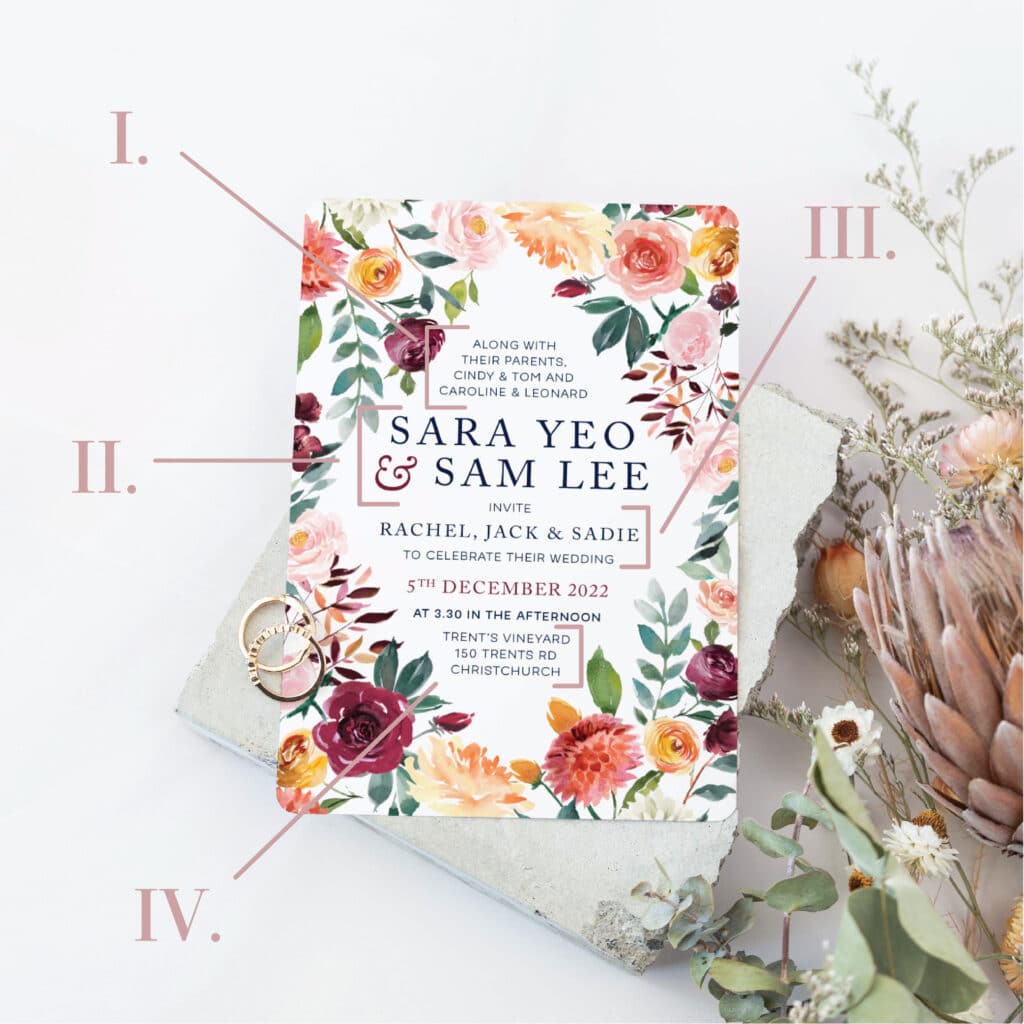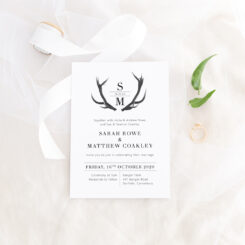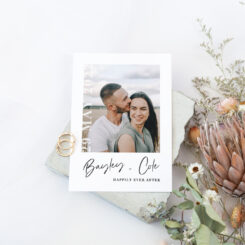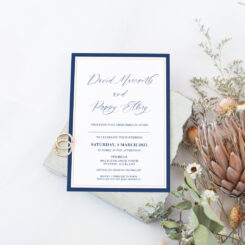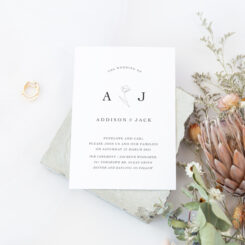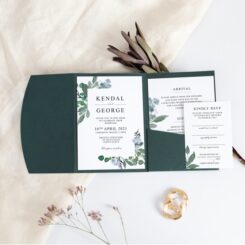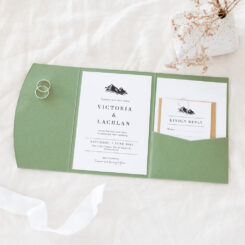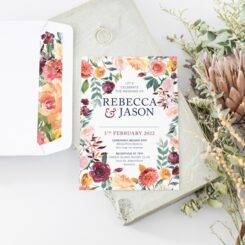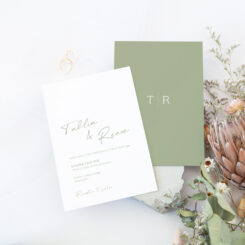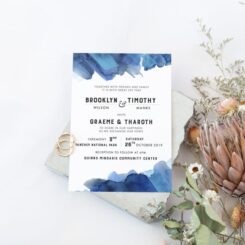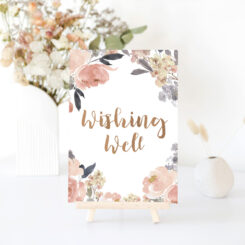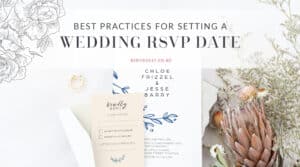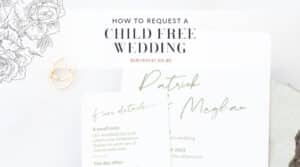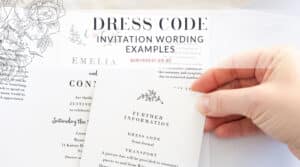Wording Wedding Invitations
You’ve got a colour scheme, sussed out a guest list and have decided on the when and where. Now let’s get to the nitty gritty. Wording your wedding invitations is a minefield of etiquette and detail to dodge. So how do you write traditional wedding invitations?
Your wedding invitations communicate important information to your guests. Of course, the all-important who, when and where - but also information on the type of wedding they can expect to attend. Does your invite say cocktail dress and fancy up-do, or jeans and a nice top?
Why are wedding invitations so important?
A properly designed invitation conveys the tone, style, theme and sets the scene for your guests. You have your perfect day sitting in your imagination. Your wedding invitation is your first chance to express this vision to your guests.

"You have your perfect day sitting in your imagination, and your wedding invitation is your first chance to express this vision to your guests"
Such a simple question has a lot of parts, and we've tried to include as much detail as possible throughout this article. So if you have a specific question, refer to our Table of Contents to skip to what's important. We also cover off when you should send out your wedding invitations in a separate post.
Knowing the applicable rules and etiquette - and the reasons behind them - means you’ll make more informed decisions on the wording of your invitations. This means you’ll be less likely to commit any etiquette no-nos that’ll send Grandma into a tailspin.
Once you know the rules and understand the traditions, you can make a conscious decision about which of those you want to keep or skip. At the end of the day, it’s your wedding, your rules. Let’s dive in.
Wording for Same-Sex Wedding Invitations
In our following examples, we've used the terms Bride and Groom to share the traditional wording rules. However there are weddings with two Brides, weddings with two Grooms, and weddings with any combination or label that a couple in love so desires to use. For the avoidance of all doubt - Be My Guest Design believes Love is Love. Anyone is welcome.
The traditional 'rules' that dictate order of names are gendered. So for clarity we have used the gendered terms to highlight the order. This may not suit you. Put your names in any order you want - the 'right way' is whatever way you want.
The only 'rule' that 'must' be followed is to make sure your parents' names are listed in the same order as you’ve chosen for yourselves, to avoid confusion (...if you are opting to have their names on the invite).

"You have your perfect day sitting in your imagination. Your wedding invitation is your first chance to express this vision to your guests."
Wedding Invitation Wording Guidelines
Wedding planning can be an overwhelming business. Your invitations are filled with details likely to stress even the most chilled nearly-wed. Learning the guidelines and understanding the 'why' behind traditions helps you can make a conscious, educated, confident decision about which of those you want to keep (or which ones to disregard). At the end of the day, it’s your wedding, your rules.
Throughout this post we have shared a number of examples. If you want more ideas, browse through our wedding invitations online to gain some inspiration. We are also happy to help you tweak your invitation wording to say 'just the right thing', so let us know if you would like some help when you submit your wording.
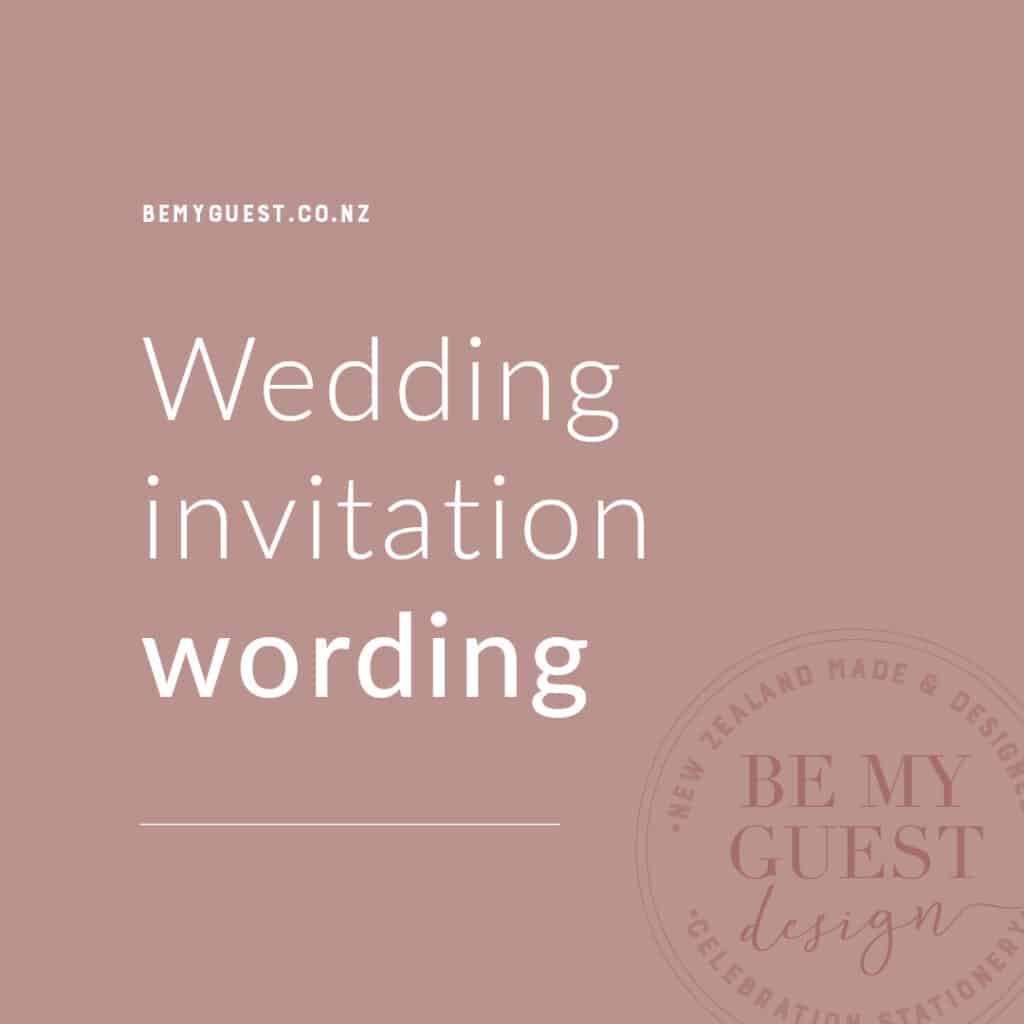
I. The hosting line AKA the introduction
Whoever was hosting the wedding (e.g. paying for the wedding) is typically listed on the wedding invitation. The bride's family was typically responsible for hosting the wedding and bearing most of the wedding expenses. However these days people list both sets of parents regardless of who is doing the paying, or use a more generic introduction.
A request line either follows the introduction/host names or is incorporated into it. This functions to say there is a wedding and this is an invitation to it.
Essential Rules to follow
If both sets of parents are hosting, the bride’s parents go first. That’s because the bride’s name goes first on a wedding invitation (more on this a bit later on).
Following this logic, the mother of the bride's name goes first, and then the father of the bride. When you go to list the groom's parents, again the mother goes first, and then the father. The reason for this is "you don't split the male from his last name" - I'm not sure why that is, it's just how I've always remembered it.
If a parent has passed away, then formal etiquette dictates that they are not on the invitation as a host. But to acknowledge the deceased parent, rewrite the host line to add "the late" in front of their name.
Traditional: The parents of the bride
Contemporary: Both sets of parents are named, regardless of who is hosting*
Alternative: Keep it generic, i.e. "Along with our families..." or "Along with our children" are popular and inclusive options
*Remember: make sure the two sets of parents' names are listed in the same order as you’ve chosen for yourselves to avoid confusion.
Example Request Lines
The request line acts to explain that this invitation is for a wedding! This line is often incorporated into the hosting line.
- Request the honour of your presence at their wedding
- Invite you to share in their joy as they exchange marriage vows
- We invite you to be with us as we begin our new life together, with a wedding ceremony
- Joyfully invite you to share in their happiness as they unite in marriage
- invite you to celebrate our wedding day together
- Request your company to celebrate their wedding day
Are your guests invited to a wedding or a marriage?
Asking guests to attend your wedding is correct. Asking them to attend your marriage is not. A wedding is the event, a marriage is the result of it. “Unite in marriage” is a fancy way of saying a wedding so that’s an option if you feel like being fancy.
-
Red Deer Antlers Wedding InvitationRated 5.00 out of 5 based on 3 customer ratings
-
Cheeky Vibes Wedding InvitationRated 5.00 out of 5 based on 1 customer rating
-
Courtly Wedding Invitations
II. Couple's names on a wedding invitation
What Order Does the Wedding Couple's Names Go in?
Traditionally, the bride's name is listed first on a wedding invitation for historical and cultural reasons. Listing the bride's name first on the invitation was a way to acknowledge her family's role and position in the event. It also represented a formal way of announcing the marriage to the community and acknowledging the bride's transition from her family's home to her husband's.
Additionally, in some cultures, it was considered customary to emphasise the bride's name as a sign of respect and honour to her family. This custom was prevalent in Western cultures, where the bride's family traditionally played a more significant role in wedding preparations.
It's important to note that wedding traditions have evolved over time, and many couples today choose to structure their wedding invitations in different ways to reflect their preferences and values.
Modern invitations use variations that include both names equally or even the groom's name first. Ultimately, how names are listed on a wedding invitation is a personal choice made by the couple or their families, and there are no strict rules governing the order.

Do you use just your first name or full name on the invitation?
Going back to the traditions - because the parents were hosting and their last names were already on the invite, the bride's first names only was listed. The theory being, it is repetitive/redundant to mention the same last name multiple times.
With the many different versions of hosting/family dynamics/modern life, it is up to your preference whether you use your first names, first and last names, or full names (i.e. including your middle names). Some people simply go by what would look good on the invitation design they've chosen. There's nothing wrong with that!
-
Lovely Lucy Wedding Invitations
-
Dreamy Greenery Pocketfold Wedding InvitationRated 5.00 out of 5 based on 2 customer ratings
-
Mountain Vista Pocketfold Wedding Invitation
III. Wording your invitations with your guest names incorporated
One perk of working with Be My Guest is the opportunity to print wedding guest’s names on their invitations.
Personalising your invitations with your guest’s names clarifies who is actually invited. It shows you've thought of them individually, creating a warm and welcoming atmosphere from the start. This can also be helpful when trying to imply children aren’t invited! Including your guests' names on the wedding invitations adds that extra touch of elegance and thoughtfulness.
- Adding guest’s names to wedding invitations & stationeryPersonalising invites with your loved one's names is an elegant introduction to your wedding festivities.
You'll want to incorporate the guest's names into your wording so that it will read properly. Read your proposed wording out loud. Does it sound right? The designers at Be My Guest are experienced in wording your wedding invitations and will offer tweaks and guidance to ensure your guest names are incorporated seamlessly on your invitation cards. More information on how to add your guest names into your invites is available here.

Examples for wording wedding invitations with guest names included
These also work if you are popping a line in and handwriting your guest’s names.
- Request the honour of Guest Names at the wedding of...
- Invite Guest Names to share in their joy as they exchange marriage vows
- ...invite Guest Names to be with us as we begin our new life together, with a wedding ceremony
- Joyfully invite Guest Names to share in their happiness as they unite in marriage
- invite Guest Names to celebrate our wedding day together
- Request the company of Guest Names to celebrate their wedding day
For a more detailed look at addressing wedding invitations, I highly recommend you read our post Adding Guest Names to Wedding Invitations where we do a deep dive into this aspect.
IV. What details to include on a wedding invitation
On a wedding invitation, the appropriate order for listing the event details is:
- date,
- time, then
- location (i.e venue).
Don't get too hung up on it though - the most important thing is that all these details are included!
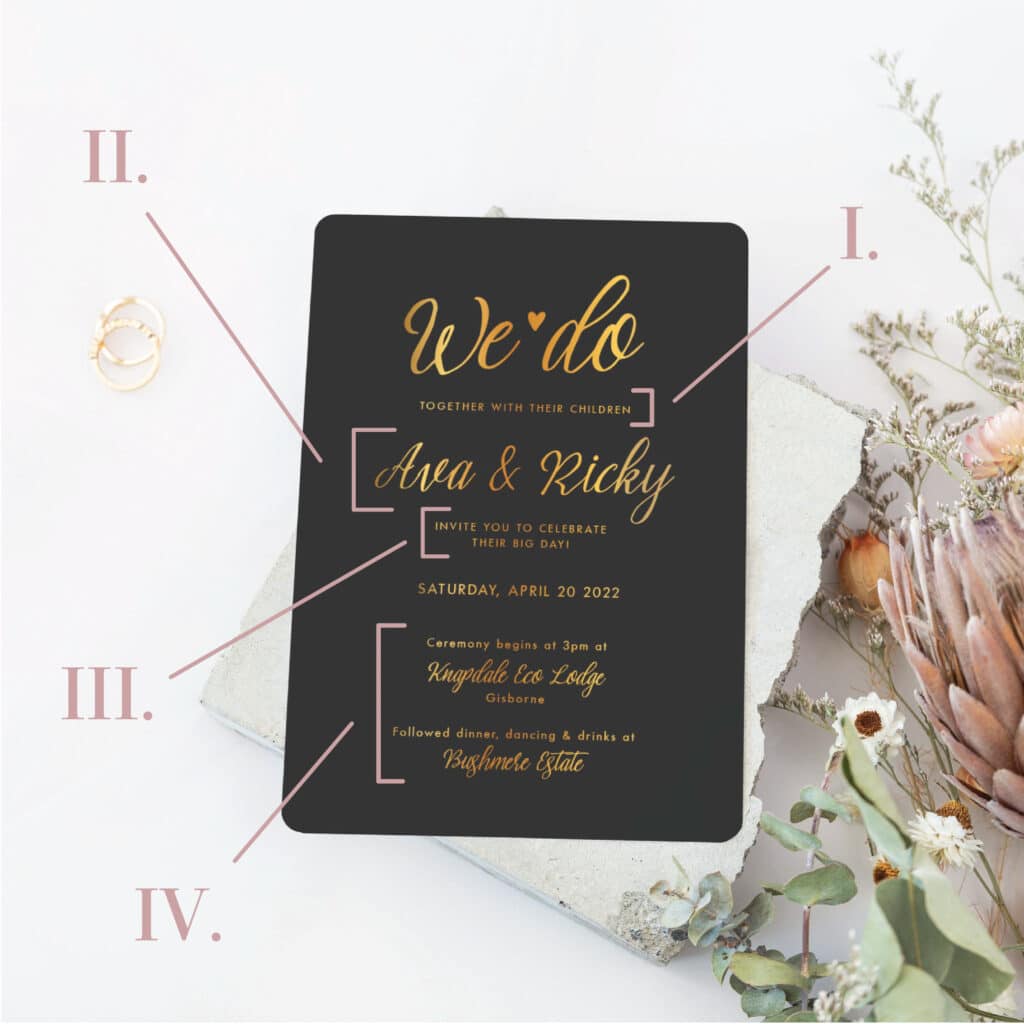
Wording examples when invited to the whole wedding
- On date at time, venue
- On date at time, venue. Cocktails, dinner and dancing to follow
- Ceremony at date, time, venue. Reception to follow at time, venue (reception is the same day, so not repeated)
- On date, at time, venue. Followed by dinner, drinks and dancing at venue (no time listed for reception - this gives you some leeway for a ceremony that runs late)
- Date, Time, Venue. Drinks, canapés and reception to follow (would be used if ceremony and reception at the same place)
Wedding invitation wording, when invited to the ceremony only
We typically print a set of invitations with differing wording, so you'd adjust your 'request line' to specify what part of the wedding they are invited to. Here's some examples of how you can make this clear:
- Please join us for a wedding ceremony on date at time, venue
- Ceremony at date, time, venue.
- ...a wedding ceremony to be held date, at time, venue.
Invited to wedding reception only: 'dance' guests
To be able to celebrate with a wider group of people, couples sometimes invite people to attend the later part of the evening after the meals and speeches. We print a set of invitations with differing wording, or a simpler invitation (as less details are required to be shared). It's important you are clear about what part they are invited to, so you don't have people turning up early when there's no seat available for them.
Here's some examples of how you can make this clear:
- Please join us to celebrate our wedding with drinks and dancing on date at later time, venue
- Wedding after-party at date, later time, venue.
- Celebrate our wedding with drinks, dancing and a supper to be held date, at later time,
Other details about your wedding details
There's a couple of rules that only apply to wedding invitations that you can choose to follow (or not!)
- Do not include a post code or RD numbers for your ceremony or reception locations. These are used for addressing mail, so it’s not necessary when supplying an address for travel.
- Line breaks are considered punctuation on a wedding invitation, so no commas or full stops are required
- If you are spelling out the numbers on your invitations, ensure you spell out all of them, including the time and the year.
- The format of time should be consistent throughout your invitations too - 3pm and 5.00 o'clock in the evening are incorrect.
- Only list the essential information on your main invitation card. Overloading your wedding guests with lots of detail and information can overwhelm people and they may overlook information that’s more important. If it is necessary to include lots of information, a separate details card or directing guests to a wedding website are a good option.
-
In Bloom Wedding Invitation
-
Modern Meadow Wedding InvitationRated 5.00 out of 5 based on 3 customer ratings
-
Painterly Wedding Invitation
Wording Wedding RSVP details
RSVP is an initialism from “Répondez s'il vous plaît” a French phrase meaning "Please respond”. So if you say Please RSVP, you are repeating yourself (Please Please Respond, in essence). Drop the please, or use the alternative “Please Reply” or "Kindly Reply".

The biggest mistake we see is setting an RSVP date months away from the wedding. If you are sending your wedding invitations the recommended twelve to 6 weeks prior, you should be setting your RSVP date about a month before the wedding. Why does this work? You need a sense of urgency - a close RSVP date motivates your friends and family to make arrangements and reply quickly. You can find best practices for setting your RSVP date here.
If you are sending your invitations out really early, hoping you will be able to finalise details in lots of time, you’re out of luck. You’ll find guests will procrastinate on replying or those who do reply early may change their plans for various reasons, leaving you feeling mucked about. Save the Dates are the ticket for getting these guests planning ahead.
Gift list wording on wedding invitations
It’s always humbling to have your friends and family shower you with gifts, and your wedding is one of those special occasions that people go all out for.
The vast majority of our couples share what type of gift they would prefer on or with their wedding invitations. So we have collated a list of gift wording examples for wishing wells, honeymoons and registries here.
Dress code wording on wedding invitations
Including a dress code on your wedding invitations sets the tone for your special day, helps guests dress appropriately, and ensures a cohesive look in your photos. Here's some ideas for sharing the dress code at your wedding.
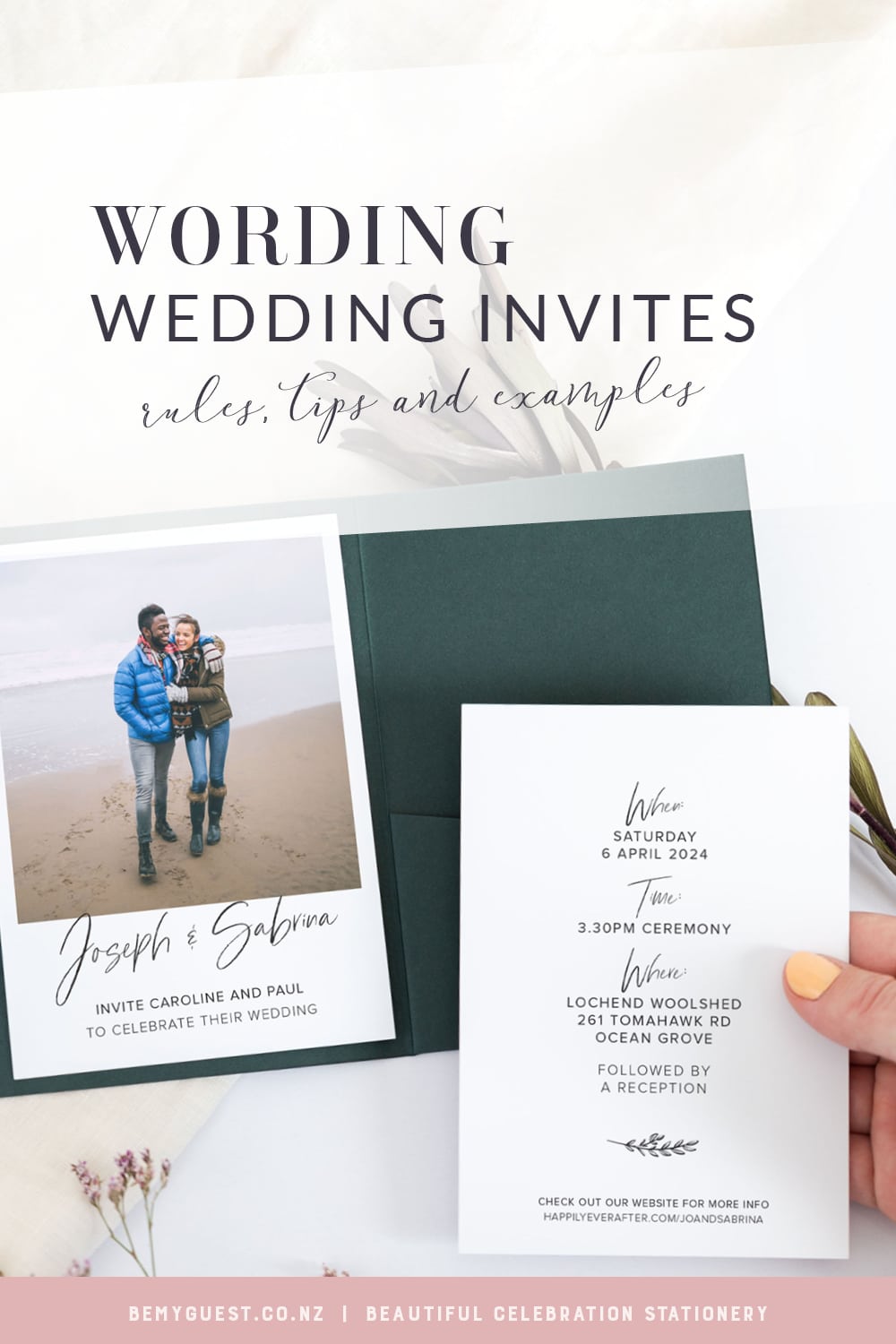
Wedding invitations wording for adults only
This is a very common question and there are many different tactics for expressing your desire for a child-free wedding. We have a whole post dedicated to this topic, you can find this here: How to request a child-free wedding.
How many wedding invitations will you need?
Once you've got the final wording pinned down and perfected, do a count up of your wedding guests to determine how many invites you need printed. You need one invitation per household - so if you have around 120 guests, you will need around 70-90 invitations. It's always handy getting extras so if you have any spare spots for last minute guests, you can give them an invitation.
Proofreading your Wedding Invitations
We've spent a lot of time on how to choose the right wording, but just as important is making sure all the details are correct. Check, check and check again because errors lead to expensive or inconvenient mistakes. Imagine a typo in the RSVP phone number. Or the incorrect street address. We have a comprehensive list of items to check over on your wedding invitations - and it's free! Download your wedding invitation proofreading checklist here.

More wording & etiquette posts from the Wedding Invitation Wording Series
- Best Practices for Setting a Wedding RSVP DateSet the perfect RSVP date with this guide to the best practices for choosing the ideal reply date, ensuring collecting RSVPs is stress free
- How to request a child-free weddingTo help you navigate having an adults-only wedding, here are some tips on sharing that you're having a child-free wedding to your guests.
- Wedding Gift WordingAdvice, tips and examples for how to ask for specific gifts on your wedding invitations, including cash/wishing wells and registry options
- Wording Wedding Dress CodesWording what wedding dress code can be tricky! Here we have examples of the different dress styles and how to specify wedding guest attire
- Adding guest’s names to wedding invitations & stationeryPersonalising invites with your loved one's names is an elegant introduction to your wedding festivities.
- Wording Wedding InvitationsWording your wedding invitations is easy with this guide. Learn the rules for wedding cards wording, plus example wording for wedding invites

Table of Contents

The Best Pens for Signing Guestbooks
We’ve trialled tons of pens for signing guestbooks. Check out the different options and things to consider.

Adding guest’s names to wedding invitations & stationery
Personalising invites with your loved one’s names is an elegant introduction to your wedding festivities.

Wording Wedding Dress Codes
Wording what wedding dress code can be tricky! Here we have examples of the different dress styles and how to specify wedding guest attire
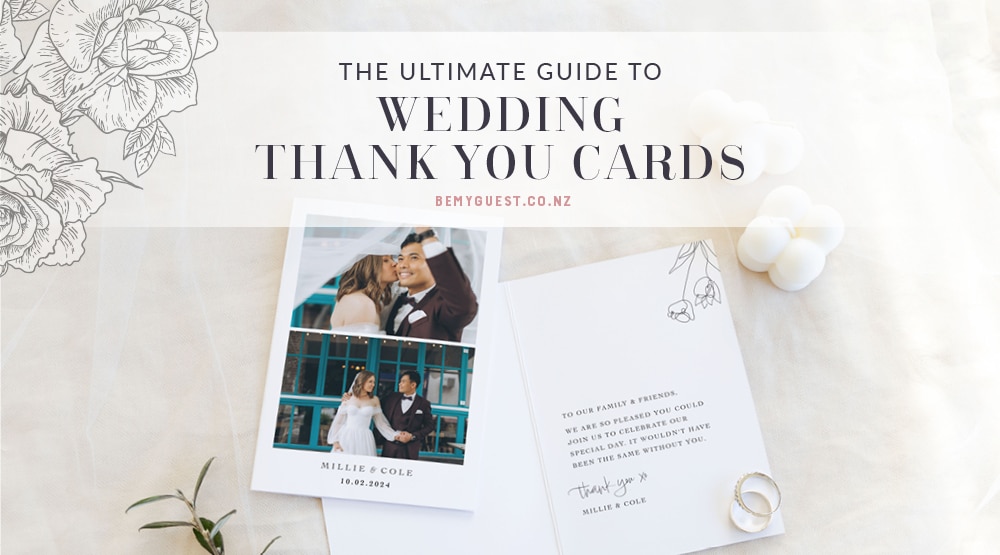
The Ultimate Wedding Thank You Card Guide
Writing your wedding thank you cards is the final wedmin task. We’ve put together the “The Ultimate Guide to Wedding Thank You Cards” to help
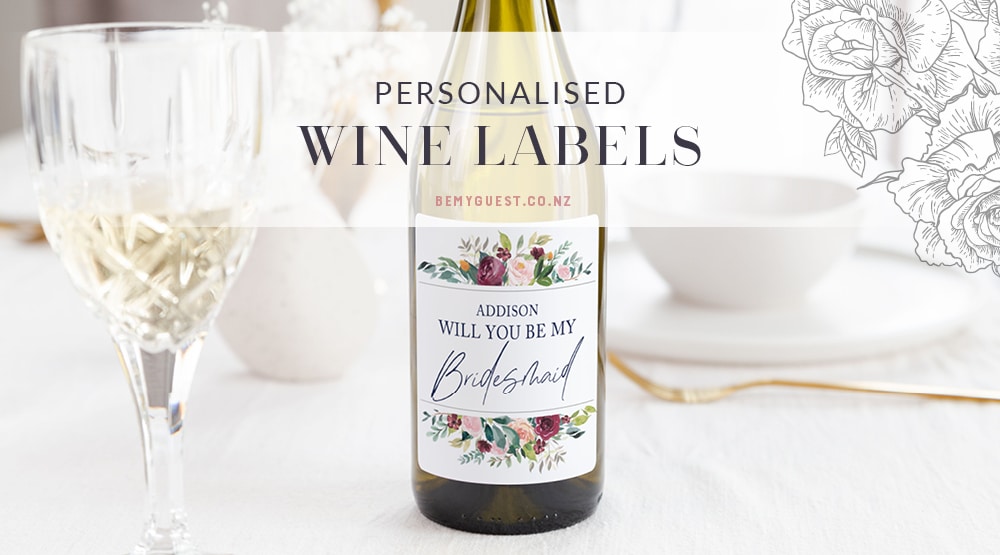
How to Apply Custom Wine Labels
Custom wine labels are a fantastic way to personalise gifts for any occasion. Here’s everything you need to know about creating, removing, and applying custom wine labels, ensuring your bottle looks perfect.
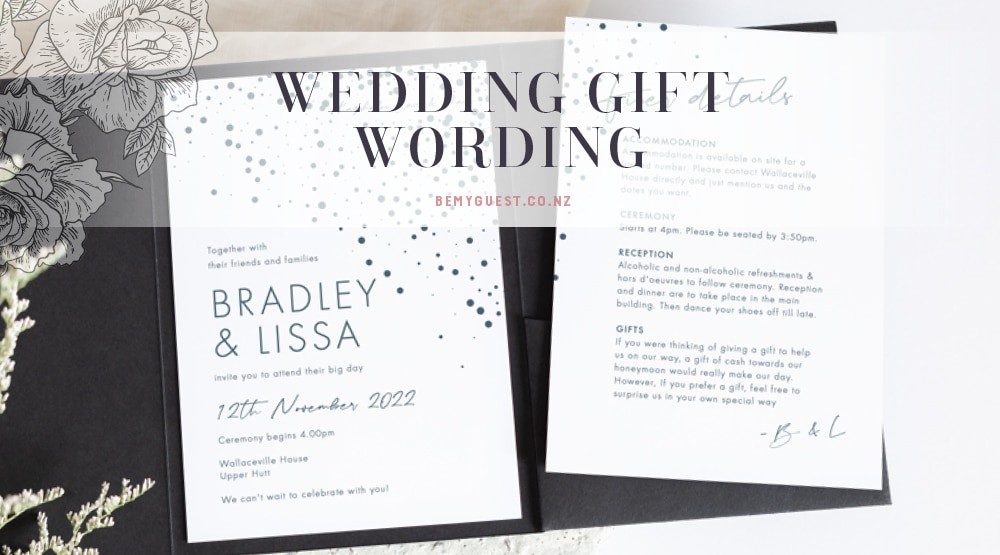
Wedding Gift Wording
Advice, tips and examples for how to ask for specific gifts on your wedding invitations, including cash/wishing wells and registry options
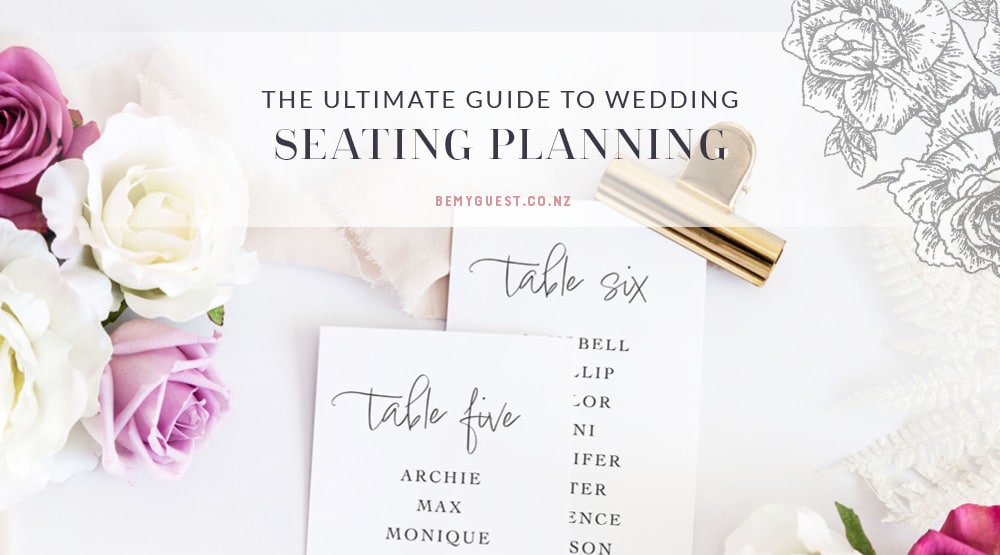
The Ultimate Guide to Wedding Seating Planning
Getting organised for your wedding reception? One of the trickiest tasks is trying to figure out where everyone will sit for the speeches and meal.
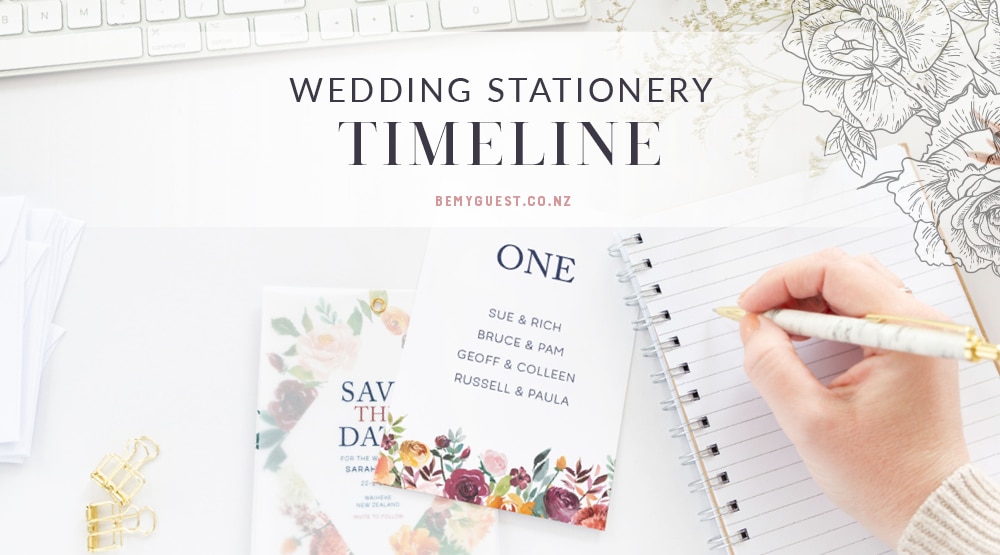
Your Essential Wedding Stationery Timeline & Checklists
This wedding invitation timeline has been developed to help New Zealand couples identify the important milestones to meet when planning, ordering and sending save the dates, wedding invitations, signage and day-of stationery
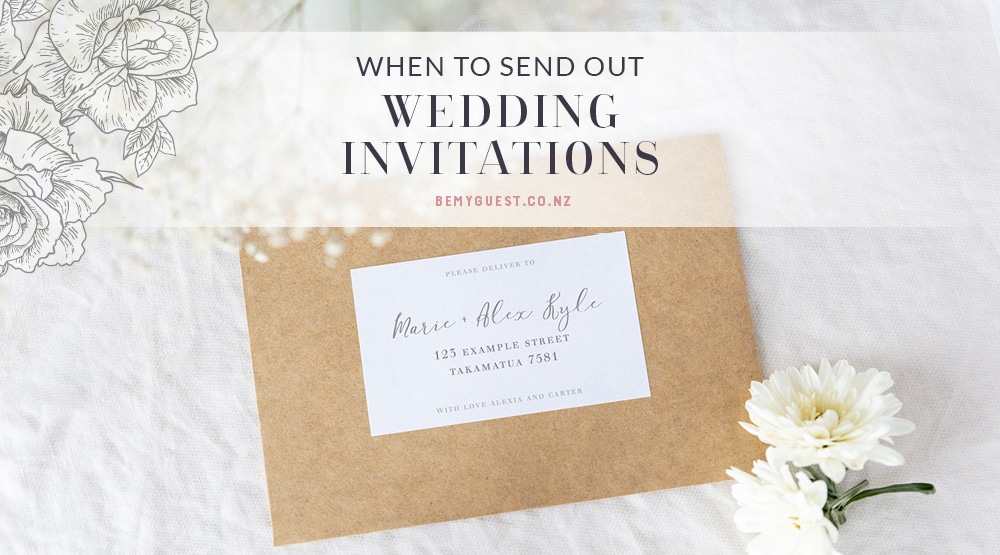
When to send out your wedding invitations
This New Zealand-specific guide covers when to send out wedding invitations to friends and family – so they have all the details to attend!
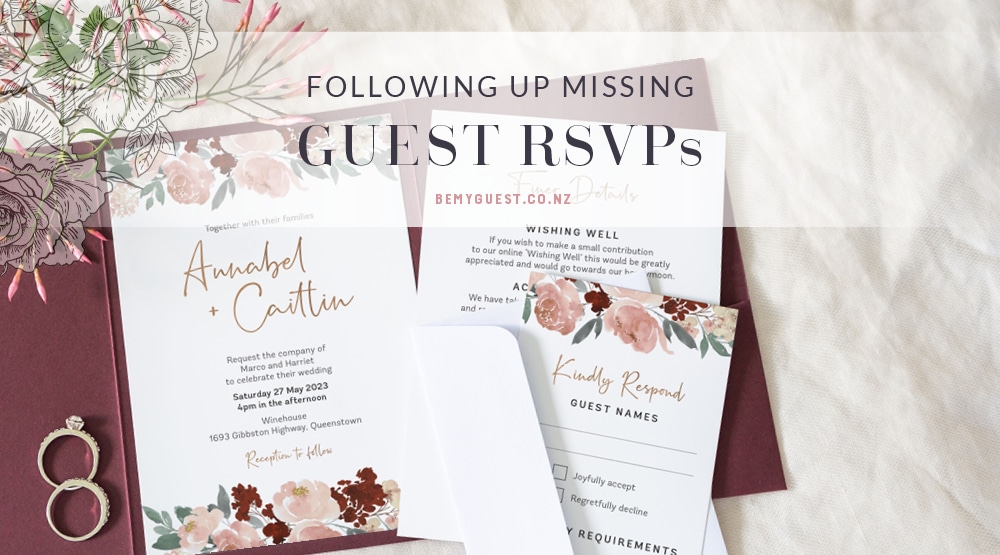
Following up guest RSVPs
Here’s our top tips for following up wedding guests who haven’t RSVPed, including our ‘magic email’ template for getting some certainty

